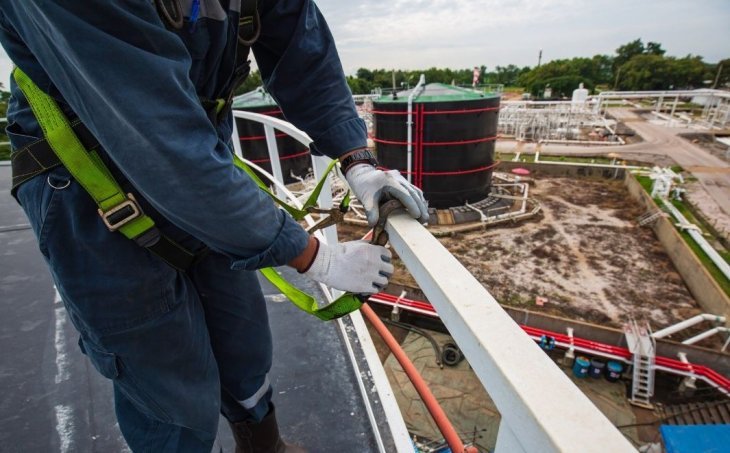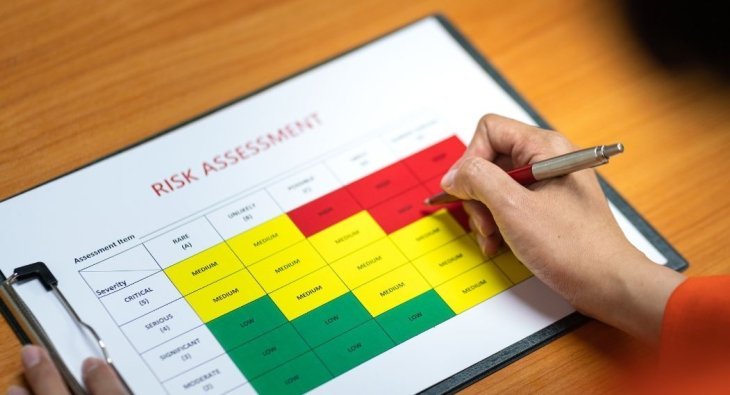In our ever-changing world, consumers expect a lot more from their customer...
Read more
 Published on 18th June 2024 by Gemma Harding
Published on 18th June 2024 by Gemma Harding
Lone worker risk assessments are needed for the safety and well-being of employees who operate in isolation.
Lone workers, often found in industries such as healthcare, security, and field services, face unique challenges that can escalate into serious hazards without immediate support.
Conducting thorough risk assessments helps identify potential dangers, comply with legal obligations, and implement effective safety measures.
A lone worker is defined as an employee who performs their job without close or direct supervision.
These individuals can be found in various sectors, including construction, utilities, and social services.
Employers have a legal and ethical responsibility to safeguard lone workers through meticulous risk assessments, and making sure they are safe and meet regulatory standards.
This guide will explore the definition of lone workers, identify specific risks they face, outline legal obligations for employers, and detail the steps necessary to conduct an effective lone worker risk assessment.

A lone worker is an individual who works in isolation from others without close or direct supervision.
Examples include home care nurses, maintenance workers, delivery drivers, and security personnel.
These workers can be found across many industries, such as healthcare, construction, agriculture, and utilities.
Lone workers are at an increased risk due to the absence of immediate assistance in case of emergencies.
For instance, a home care nurse visiting patients alone may face health emergencies or aggressive behaviour without support.
Similarly, a maintenance worker performing tasks in remote locations might encounter environmental hazards or equipment malfunctions.
Typical scenarios faced by lone workers include performing tasks in remote areas, working outside regular hours, or engaging in high-risk activities without nearby colleagues.
Recognising these roles and scenarios is the first step in understanding the importance of tailored risk assessments for lone workers.
Lone workers face many risks and hazards that can significantly impact their safety and well-being.
Common risks include slips, trips, and falls, which are even more dangerous when no one is around to assist.
Additionally, lone workers might face environmental hazards such as extreme weather conditions or dangerous wildlife, particularly in remote or rural locations.
Situational factors also contribute to increased risks.
For example, working late hours or in high-crime areas can expose lone workers to the threat of violence or theft.
The lack of immediate support and supervision means that any incidents can escalate quickly, with potentially severe consequences.
Beyond the obvious physical hazards, lone workers may also face psychological risks.
The isolation inherent in their roles can lead to increased stress, anxiety, and feelings of vulnerability.
Identifying these less obvious risks is essential to create a comprehensive safety plan.
To effectively identify these risks, employers should engage with lone workers, review incident reports, and conduct regular site inspections.
Understanding the full spectrum of risks allows for the development of targeted strategies to reduce them.
Employers have a legal duty to the safety and health of all employees, including those working alone.
In the UK, several regulations and standards outline these responsibilities, such as the Health and Safety at Work Act 1974 and the Management of Health and Safety at Work Regulations 1999.
Non-compliance with these regulations can lead to significant legal and financial repercussions, including fines, legal action, and reputational damage.
Employers must conduct risk assessments, provide adequate training, and implement effective safety measures to protect lone workers.
Specific legislation, such as the Corporate Manslaughter and Corporate Homicide Act 2007, underscores the seriousness of these obligations.
This act makes it possible for organisations to be prosecuted if a gross breach of duty leads to a worker’s death.
Best practices in meeting these legal obligations include conducting regular risk assessments, involving lone workers in safety discussions, and staying updated on legislative changes.
Employers should also document all safety measures and that they are easily accessible to all employees.
By sticking to these practices, businesses can not only comply with legal requirements but also foster a safer working environment for lone workers.

Conducting an effective lone worker risk assessment involves a series of structured steps to ensure the safety and well-being of employees who work alone. Here’s a step-by-step guide:
By following these steps, employers can create a safer working environment for lone workers, minimising risks and enhancing their overall well-being.
When assessing risks for lone workers, several key factors must be considered.
The time of day is a major element; working late at night or early in the morning can increase the risk of accidents and incidents due to reduced visibility and fatigue.
The location of work also plays a significant role, with remote or isolated areas presenting higher risks due to limited access to emergency services.
The type of work being performed is another major factor.
Tasks involving hazardous materials, heavy machinery, or working at heights can be particularly dangerous for lone workers without immediate assistance.
Additionally, the use of specific equipment requires careful evaluation so that proper safety protocols are in place.
Psychological factors, such as stress and mental health, must also be considered. Isolation can exacerbate feelings of anxiety and depression, impacting the overall well-being of lone workers.
Employers should assess the mental health risks and implement supportive measures.
Evaluating the severity and likelihood of identified risks is essential. This involves considering the potential consequences of each risk and the probability of occurrence.
By prioritising these factors, employers can focus on mitigating the most significant risks first, and a safer environment for lone workers.
Implementing effective control measures is crucial for mitigating risks faced by lone workers.
Strategies to eliminate risks should be prioritised, such as automating hazardous tasks to remove the need for human intervention.
Where elimination isn’t feasible, risk reduction through changes in work practices or environments is essential.
For instance, adjusting work schedules to avoid high-risk times or improving workplace lighting and security can significantly reduce dangers.
Protective equipment plays a large role in safeguarding lone workers.
Providing appropriate personal protective equipment (PPE), such as helmets, gloves, and high-visibility clothing, helps minimise injury risks.
Workers need to be trained in the correct use and maintenance of PPE is equally important.
Effective monitoring and communication technologies further improve safety.
GPS trackers allow real-time location monitoring, while emergency distress signals enable immediate alerts in case of danger.
Two-way communication devices ensure continuous contact between lone workers and supervisors.
Implementing a reliable check-in system, where lone workers regularly report their status, adds an additional layer of safety, along with the use of a telephone answering service can help get to potential issues quickly.

Technology plays a major role in lone worker safety.
Various technological solutions can be integrated into safety protocols to provide real-time monitoring and rapid response capabilities.
GPS trackers allow employers to monitor the location of lone workers, and that they can quickly locate and assist them in emergencies.
Emergency distress signals are another type of technology that helps workers send immediate alerts if they encounter danger or require assistance.
Some systems are equipped with automatic fall detection, triggering an alert if a worker becomes incapacitated.
Communication tools, such as two-way radios and mobile apps, facilitate continuous contact between lone workers and their supervisors, meaning issues are promptly reported and addressed.
Apps and monitoring software are highly effective, allowing real-time data collection and analysis to identify patterns and potential risks.
Integrating these tools into daily safety protocols helps manage risks proactively.
Employers can implement these technologies to make sure lone workers are consistently monitored and supported, and improving their lone worker solutions overall.
Providing comprehensive training programs for lone workers is essential for their safety and preparedness.
Training should cover risk identification, emergency response procedures, and the proper use of safety equipment.
Workers must be equipped with the knowledge to handle potential hazards they might encounter in their roles.
Regular refresher courses are crucial to keep lone workers updated on the latest safety protocols and practices.
These courses reinforce existing knowledge and introduce new safety measures or technologies.
Employers should provide resources for further reading and support, such as safety manuals, online courses, and access to health and safety experts.
Making training accessible and engaging is key to its effectiveness.
Interactive sessions and scenario-based learning can help retention and application of safety practices.
Ongoing review and updates of risk assessments are essential to maintaining the safety of lone workers.
Regular reviews mean that any changes in the work environment, job tasks, or regulatory requirements are promptly addressed.
This proactive approach helps identify new risks and implement appropriate control measures.
Triggers for review include changes in work scope, new equipment or processes, and incidents or near misses.
Conducting reviews after significant changes or events means that risk assessments remain relevant and effective.
A recommended timeline for regular reviews is at least annually, though more frequent reviews may be necessary in dynamic or high-risk environments.
Adapting risk assessments to incorporate technological advancements and legal changes is also essential.
By maintaining up-to-date risk assessments, employers can continuously improve safety measures and a safer working environment for lone workers along with compliance with legal obligations.
Isolation can significantly impact the safety and well-being of lone workers.
Physically, the absence of colleagues means that any accidents or injuries may go unnoticed for longer periods, increasing the severity of incidents.
Mentally, isolation can lead to heightened stress, anxiety, and feelings of loneliness, all of which can negatively affect a worker’s performance and decision-making.
To reduce the impact of isolation, employers should establish robust support systems. Regular check-ins and communication can help lone workers feel connected and supported.
Encouraging workers to take regular breaks and providing access to mental health resources can also alleviate the negative effects of isolation.
Emergency response planning is a major component of lone worker safety.
A well-structured emergency response plan outlines the necessary steps to take in various emergency scenarios, and that lone workers can receive timely assistance.
Key components of an effective plan include clear communication channels, designated emergency contacts, and detailed procedures for different types of emergencies, such as medical incidents, accidents, or security threats.
Clear communication channels are needed to allow lone workers to report emergencies quickly.
Employers should provide reliable communication devices, such as mobile phones or two-way radios, and establish protocols for regular check-ins.
In case of an emergency, these channels mean that lone workers can reach out to incident management services.
Strategies for rapid response and assistance from incident management services include training workers in first aid, providing access to emergency medical services, and implementing location tracking technologies to find a worker’s exact location.
Regular drills and practice scenarios can help workers become familiar with the procedures and respond effectively in real emergencies.
Lone workers need to receive prompt assistance and support during these difficult situations.
Building a strong safety culture is essential for protecting lone workers.
This culture emphasises safety at all organisational levels and encourages proactive participation in safety practices.
Involving lone workers in safety initiatives is crucial; their firsthand experiences help identify hazards and develop effective safety measures.
Employers should provide continuous safety training, encourage open communication about safety concerns, and recognise and reward safe behaviours.
By creating a proactive safety environment, employers make sure safety is a shared priority and employees feel empowered to contribute to their safety and that of their colleagues.
Mental health is required for lone worker safety.
The isolation and stress associated with working alone can lead to anxiety, depression, and burnout.
Employers must prioritise mental health support for workers’ well-being.
Guidelines include providing access to mental health resources, such as counselling services and helplines.
Regular check-ins and opportunities for social interaction can help reduce isolation.
Training managers to recognise signs of mental distress is also essential.
Integrating healthcare services provides lone workers with access to comprehensive mental health support, they receive necessary care and assistance.
Effective monitoring and reporting are crucial for lone worker safety.
Employers should use tools such as GPS trackers, mobile apps, and check-in systems for real-time monitoring.
Clear protocols for reporting incidents, near misses, and safety observations are essential.
Providing easy-to-use reporting tools encourages prompt and accurate reporting.
Analysing incident reports helps identify patterns and areas for improvement.
Regular review of these reports refines safety measures and prevents future incidents.
Reliable Incident Management Services streamline the reporting process and improve overall safety management and a safer working environment for lone workers.
Conducting thorough risk assessments for lone workers is essential for their safety and well-being.
Lone workers face unique challenges requiring tailored safety measures and ongoing support.
By understanding who qualifies as a lone worker, identifying specific risks, and meeting legal obligations, employers can create a safer working environment.
Effective risk assessments involve preparation, worker engagement, and documentation.
Implementing control measures, leveraging technology, and providing comprehensive training are crucial steps.
Regularly reviewing and updating risk assessments helps towards continued effectiveness.
Using a proactive approach, employers make sure that lone workers are protected, supported, and empowered to perform their roles safely and efficiently